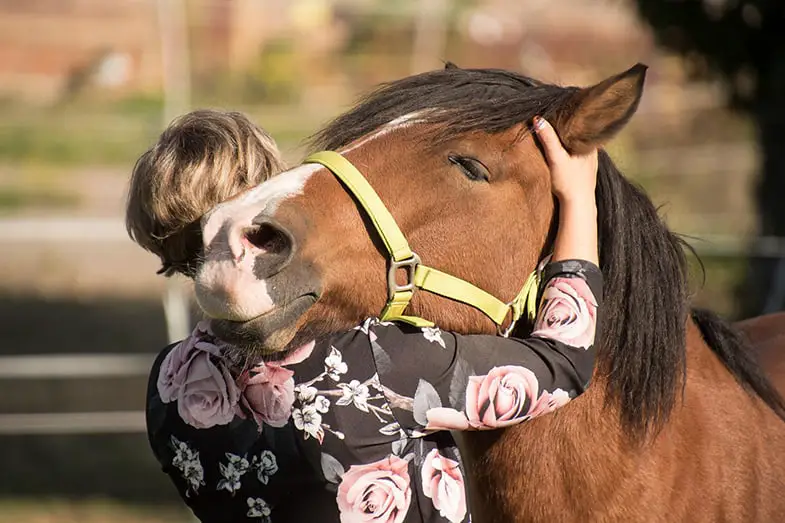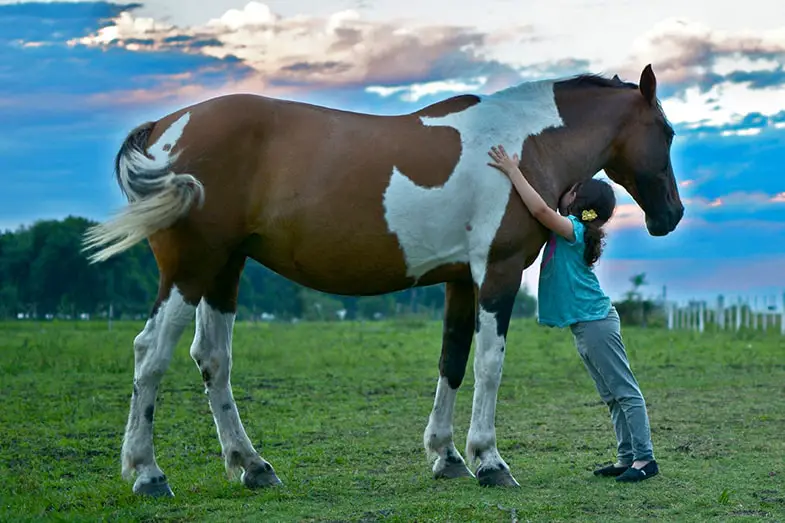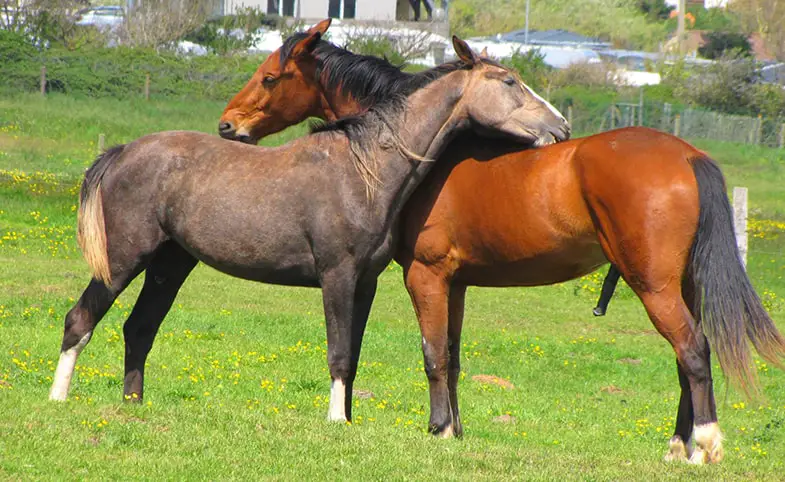If you’re anything like me you’ll love giving your horses hugs but have you ever thought about whether they like being hugged as much as we enjoy hugging them? I know most of us will say that we know our horses, but what if you’re new to the horsey world, how can you tell if horses really like being hugged or not?
Do horses like to be hugged? Horses are social animals and while they may not interpret a hug in the same way that we would they do understand and appreciate the significance behind it.
Do horses like to be hugged?
It would be wrong to suggest that a horse fully understands what a hug means but that doesn’t mean to say they don’t like it and that they don’t want to be hugged at all. In actual fact horses regularly ‘hug’ each other as a way of bonding and re-establishing their position within the herd. They just hug each other in a different way.
While it’s easy to see, from herd behavior, that horses like to be hugged it’s also worth mentioning that they absolutely understand what a hug means to us. I know you probably think it’s impossible to know that for sure and to some extent yes that’s true, but you only need to see how horses interact with their owners when they (the owner that is) are upset. Most horses will instinctively move towards the person and rest their head against them, they seem to know that a hug from them can make us feel a lot better and lift our mood too.
Hugs aren’t the only way that horses show their devotion to their owners though. If you want to know more about how horses show affection check out my recent article on the subject.
How can you tell if a horse is happy to be hugged?
You can’t simply walk up to any horse and expect them to allow you to throw your arms around them (and you should never even try without asking the owner’s permission). Being prey animals, horses may think you’re going to attack them if they’re not expecting you to give them a hug. Instead, you need to wait until the horse gives you permission to hug them.
I know that might sound like a daft thing to say but if you make the horse aware of your intentions first then you’ll get a far better response. You can do this easily by approaching the horse and stopping when you’re just under an arm’s length away from them and raising the back of your hand towards their nose, stopping when you’re an inch or two away from it. They’ll sniff your hand to assess you and, if they’re happy you’re not a threat they’ll touch your hand with their nose. If they do this then you’ve got their permission to stroke them, do this gently along their neck and slowly put your arms around their lower neck and withers. Keep watching the horse though and if they show signs they’re not happy (such as putting their ears back, flicking their tail, or starting to back away) then move your arms away from their neck and talk to them in a calm voice to reassure the horse.
Once you’ve developed a relationship and built a bond with a horse then they’ll understand you’re not going to hurt them and will happily receive any number of hugs from you, they may even reciprocate by hugging you too.
Where should you hug a horse?
The most common place to hug a horse is around their withers but to be honest, horses all horses are different so prefer to be hugged differently. We’re always told to be careful around the back of a horse but I’ve known many horses that would be delighted if you gave their backside a great big hug. Conversely, I’ve known a few horses that don’t like to be cuddled anywhere at all.
As I say though, most horses prefer to be hugged around the neck, withers, and shoulders but some are also happy for small children to hug their front legs if they’re unable to reach their necks. Some horses are also happy for you to cuddle their heads while others don’t feel comfortable with people being that close.
The best advice I can give if is to pay attention to the horse and if they seem unhappy don’t give them a hug.
How do horses give hugs?
I know I’m stating the obvious when I say horses don’t have hands or arms but this means that they can’t hug us in the same way that we hug them. That doesn’t mean to say though they can’t reciprocate the affection we’re showing them, they just do it in a different way so use body contact to show affection instead.
When being hugged some horses will wrap their neck around your back and hug you with their head although this doesn’t always happen and it doesn’t mean anything if the horse doesn’t return your hug. Instead, most horses hug people by lowering their heads and resting (or pressing) them against us. To the horse, he’s sharing body contact with you and therefore showing you affection.
Do horses hug each other?
Being herd animals ‘hugging’ is very important to horses but just because they don’t have arms to put around each other it doesn’t mean to say they don’t give each other ‘horsey’ hugs. They are actually a few different ways horses hug other horses. The most common of these is known as mutual grooming and involves two horses standing side by side (nose to tail). They will both stretch their necks over each other’s back and begin to groom each other by gently nipping with their teeth, although they don’t always nip.
If you’ve ever seen a mare and her foal together you’ll have noticed how she gently hugs her foal by tucking her head around them and hugging with her neck. This is done to measure the foal but also as a pure sign of affection between the mother and foal.
Can you teach a horse to give you a hug?
You might think that you can’t teach a horse to give you a hug on command but it’s actually easier than you might think. Of course, you can reward your horse with treats every time he does give you a hug but some horses will expect a treat and may become grumpy and pushy if they don’t get a treat. Instead, it’s better to use positive reinforcement to train your horse to hug you.
This can easily be done by gently lowering your horse’s head while also applying a little bit of pressure to the top of their neck. As soon as they move in the direction you’ve asked them to, release the pressure and praise them. At the same time as doing this, you should also use a verbal cue (such as the word ‘hug’), this will help your horse to associate the word with the action and in time can be used to trigger the behavior.
Over time, using positive reinforcement will teach your horse to give hugs when you ask for them. At this point, it’s worth pointing out that this is something I’ve never done, not because there’s anything wrong with it but because I prefer to get ‘real’ hugs from my horse. I know that might sound silly to say but I’d rather my horses gave me hugs when they felt like it rather than when I asked for it, that’s just my opinion though.
I hope you found this article helpful. If you did I’d be grateful if you could share it please as it would really help me.
Recommended products
Over the years I have tried hundreds of different horsey products, from various blankets and halters to different treats. Some I’ve loved, others I’ve hated but I thought I’d share with you my top all-time favorite products, the ones I never leave the yard without. I’ve included links to the products (which are in no particular order) that I really think are great.
- Horse Knots by Reference Ready – If you’re like me and enjoy pocket reference guides then you’ll love this knot tying guide. These handy cards can easily fit in your pocket or attach to the saddle for quick reference. They’re waterproof, durable and are color coded to make them easy to follow.
- Mane ’n Tail Detangler – Even if you never show your horse you’ll need to detangle his tail from time to time (and possibly his mane too) which is always a challenging chore! I’ve found that if I run a little bit of detangler through my horse’s tails every few days it stops them from getting matted up and makes combing them easy, even if they’re coated in mud. I don’t know if I should admit to this or not but it also works wonders on my hair.
- TAKEKIT Pro clippers – Over the years I’ve tried a lot of different clippers and while some were obviously better than others I found these to be by far the best. They are heavier than a lot of other clippers but for me, that’s a good thing, it makes them feel more sturdy and hardwearing. On top of that they have a range of speeds so are just as good for clipping your horse’s back as they are his face. I also like the fact that they come in a handy carry case but that’s not for everybody. The company that makes them is super good and incredibly helpful too, a real bonus these days. The only thing I wasn’t keen on was the fact that it doesn’t come with any oil, but that’s not a major problem as it’s not difficult to buy lubricant.
- Shire’s ball feeder – There are so many boredom buster toys out there but I like to use these every day, regardless of whether or not my horses are bored. I find that it helps to encourage my horses to problem solve by rewarding them with treats (or pieces of fruit) but it also mimics their natural grazing behavior which helps to keep them calm and de-stressed.
- Horse safe mirror – This is a strange one that many people are surprised about but I like to put horse safe mirrors in the trailers as well as in the quarantine stalls. It helps to prevent the feeling of isolation by giving the impression of other horses being around. Being herd animals horses can get extremely stressed when they feel that they’re on their own but with these stick-on mirrors, they believe that at least one other horse is with them.
- Rectal thermometer – I know this isn’t glamourous at all but it’s vital for your horse’s well-being to be able to check their temperature and a rectal thermometer is the easiest way of doing this which is why I’ve added it to the list.
Shopping lists
I’ve also put together a few shopping lists of essential items that I’ve found helpful over the years. I’ve broken the lists down into different categories rather than put everything in one massive list 😉



